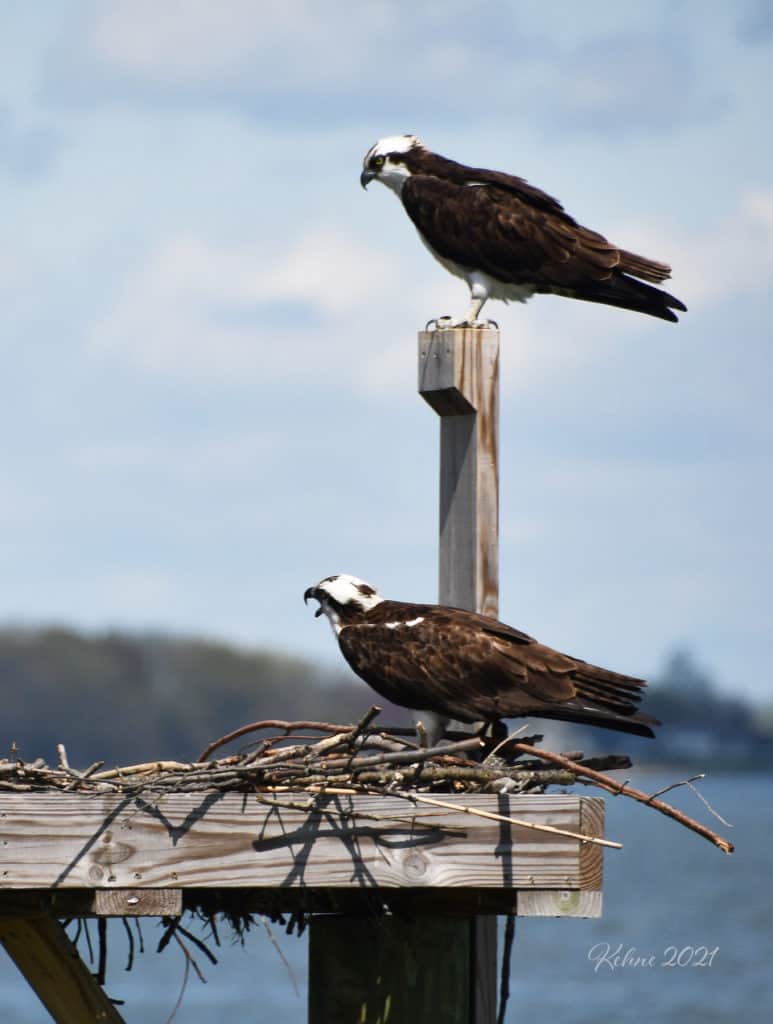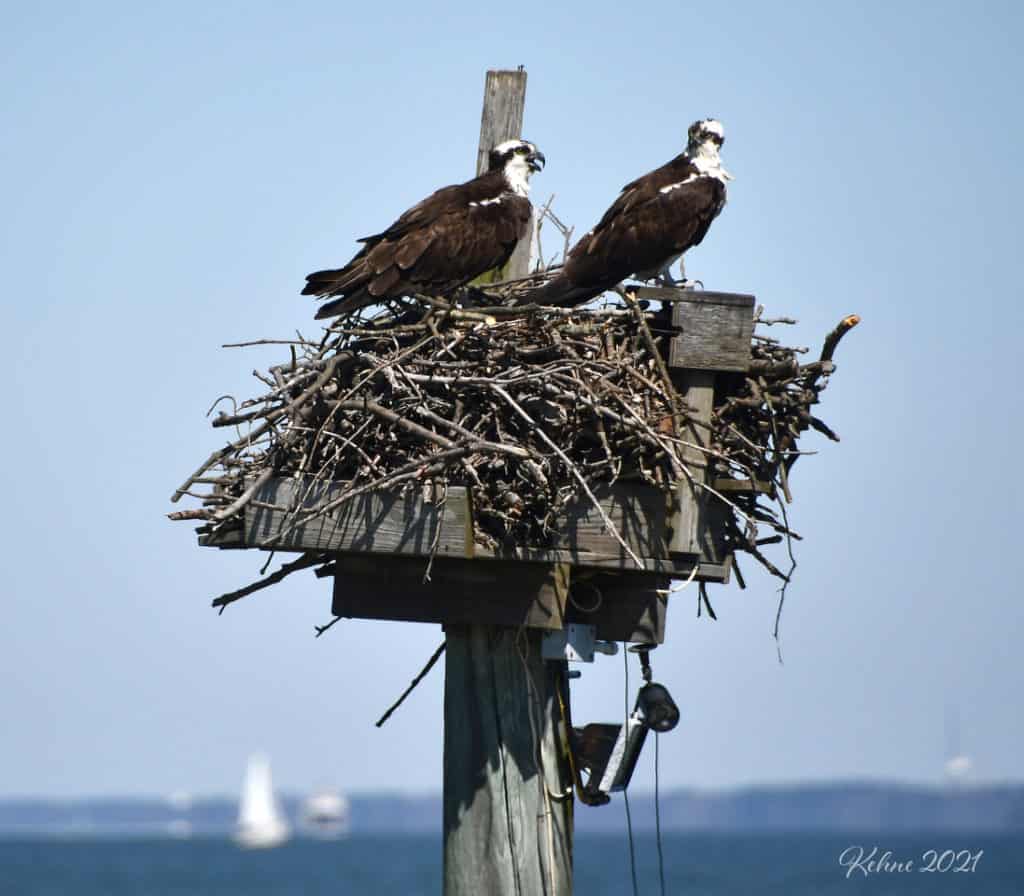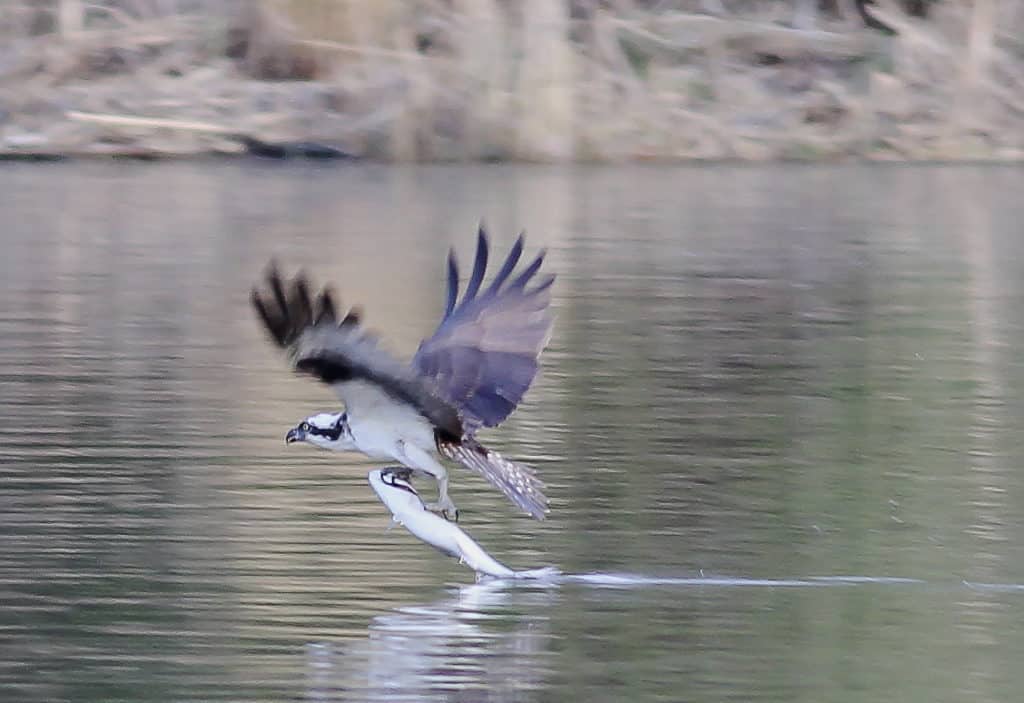Sharing Spaces

Can ospreys and humans live in harmony?
By Steve Adams
Most Marylanders are familiar with the osprey. We track their arrivals and departures, we watch them on webcams, we marvel at their nest engineering.
But once in a while, ospreys end up somewhere humans don’t want them, usually an inconvenient nesting site, occasionally dropping their seafood dinner on your car or lawn. A recent incident had a lot of Chesapeake Country talking—not about the dangers of a nest atop a pole, but for what happened to the young birds inside.
News broke last week that two juvenile ospreys had been euthanized after their nest was removed from a light pole at a baseball field in Calvert County’s Cove Point Park in Lusby.
The county had contacted the U.S. Department of Agriculture for help removing the birds so that a light pole could be replaced. USDA’s Animal and Plant Health Inspection (APHIS) Wildlife Services is the federal agency that resolves “conflicts to allow people and wildlife to coexist”. The organization “uses an integrated approach to solving conflicts, such as those associated with osprey, and considers a wide range of lethal and non-lethal methods”.
According to Tanya Espinosa, public affairs specialist for APHIS, the county parks department requested the removal of the nest at the ball field “due to human health and safety and property maintenance concerns.”
Espinosa says personnel subsequently removed the nest and euthanized two immature birds, “estimated to be 30 days of age and not close to fledging,” under the authority of a depredation permit issued by the U.S. Fish and Wildlife Service (USFWS).

“WS works closely with the Maryland Department of Natural Resources and the U.S. Fish and Wildlife Services to ensure sound management decisions,” she added. “Osprey population recovery has been a conservation success in this region. Once nearly extirpated before the 1970s due to use of certain pesticides, the Chesapeake Bay area is now home to more than 2,000 nesting pairs. As trained and dedicated wildlife management professionals, WS carefully considers the decision to remove individual birds and lethal removal is done with consideration for the population of the species as a whole.”
Despite the authority of the USDA to undertake these actions at Cove Point Park, many citizens were clearly disturbed to learn of the outcome and quickly took to social media to proclaim their shock and horror.
Hundreds of members of the MD Birding Facebook group, which totals about 16,500 members, said neither the USDA nor Calvert County did the right thing. “Why couldn’t they just wait a few weeks?” asked one commenter. “Seriously … how can they do this?,” wrote another. “There is no acceptable reason for it all. So sad and such disregard for wildlife. Anyone that signed off on this should be ashamed of themselves.”
One member expressed frustration at the darker side of managing wildlife. “Argghh – I guess their excuse is we have enough osprey already so disposing of a few ‘inconvenient’ babies makes perfect sense. I’m heartbroken for the two babies who didn’t get a chance to live out their lives, the parents who spent a season nest-building, incubating eggs, and successfully raising their young, just so some selfish, cruel humans can kill them according to a senseless narrative. People who prefer to kill wildlife instead of choosing a non-lethal relocation should get another profession. They should NOT be in charge of our natural resources, period.”
When a citizen shared photos of the ospreys’ removal on Facebook (in a post that has since been deleted), they were under the impression that the birds would be “taken to a rehabilitation center in Annapolis and will (be) in very good hands and will be released back in the Park when they are ready next season.”
But that’s not what happened.
Residents and wildlife enthusiasts turned their ire to the Calvert Board of County Commissioners, asking why the nest couldn’t have been removed after the ospreys had fledged or why the birds were euthanized without contacting one of the nine licensed wildlife rehabilitators in Calvert County—including two right in Lusby.
BOCC issued the following statement:
“We have received a number of comments and questions regarding the removal of an osprey nest from a light pole at Cove Point Park.
Because the nest was located in an area adjacent to a ball field, the nest posed a risk to the safety of the public; the light pole at Cove Point Park is not equipped to accommodate the presence of ospreys. The presence of the nest could endanger visitors to Cove Point Park with the risk of falling sticks or other nesting material.
Calvert County Government enlisted the services of U.S. Department of Agriculture (USDA) Animal and Plant Health Inspection Service Wildlife Services, through a cooperative services agreement, to remove the nest. Due to the nature of this agreement, Calvert County Government was not consulted or informed as to why or how the decision was made to euthanize the juveniles in the nest rather than relocate. For the safety of the birds we often enlist the services of USDA.
Moving forward we will work to ensure that any ospreys removed from county property will be relocated and will communicate this position with USDA. We appreciate and value the outpouring of concern for our county’s natural resources. The county is in the process of installing lights equipped to safely accommodate the presence of ospreys at our parks, to enable wildlife to coexist in our recreation spaces.”
There have been precedents for ospreys being successfully relocated or rehabilitated when they move into human territory—stories with happier endings.
In April, three Natural Resources Police officers made the news after constructing a new nest on a piling for two ospreys after removing their nest from an abandoned boat at Goodhands Creek Landing in Chester.
And just last week, a juvenile female osprey that had been seen hanging upside down from her nest in Shady Side with twine wrapped around one leg took flight and returned to the nest after being taken to and rehabilitated at the Owl Moon Raptor Center in Boyds, a state and federally licensed wildlife rehabilitation center specializing in birds of prey.
Naturally, the outcry surrounding what occurred at Cove Point might make you wonder what you can do, or should do, when you see an osprey nest somewhere too close to humans.
According to David F. Brinker, regional ecologist with the Maryland DNR’s Wildlife and Heritage Service, it’s not about where, but rather when and in what condition, you see the nest.
While Brinker withheld comment on the situation in Cove Point, given his lack of personal involvement in the matter, he says it’s common to see nests on all sorts of manmade structures akin to ospreys’ most natural nest location, dead trees. “We see nests on channel markers, power poles, telecommunication towers, barges, abandoned and unused boats, roadside billboards, and specially-designed platforms that landowners put in place to entice ospreys to nest on their property or in a location where people can easily watch the nesting process from start to finish.”
Wherever their nests are, ospreys are protected under the Migratory Bird Treaty Act (MBTA), which “prohibits the purposeful take or attempting to purposefully take any migratory bird, nest, and eggs or parts thereof, unless permitted by USFWS,” and USFWS’s Chesapeake Bay Field Office (CBFO) is responsible for evaluating impacts of projects or activities on migratory birds in Maryland, Delaware, and D.C.
CBFO states that in the Chesapeake region, nests can be removed without a migratory board permit or permission from September through February, when they are deemed inactive due to ospreys being at their wintering grounds in Central and South America, or at any time if there are no eggs or young present in the nest or if the eggs fail to hatch by July 15.
However, CBFO notes that “A nest should only be removed if it threatens human health or safety, poses potential risk of injury to the osprey parents or their offspring, or conflicts with normal use or function of property or equipment.” It also states that “once removal of a nest has begun, you must be vigilant and continue to remove sticks. Ospreys are persistent nest builders and will do so for several weeks to follow. If ospreys lay eggs while you are actively trying to remove the nest, you must cease all activities.”
CBFO also makes it clear that the public can do much to avoid and minimize its disturbance to ospreys, like retrofitting problematic nest sites during the non-nesting season (September through February) or constructing artificial nest poles or platforms above undesired nest locations. Use common sense to limit disturbing the ospreys. Fror example, avoid parking directly under a nest like the one I recently spotted atop a light in the Westfield Annapolis Mall parking lot.
Finally, and most importantly, if and when you think an occupied nest may need to be removed during nesting season (March through August), CBFO states that you must contact the USDA Wildlife Services hotline at 1-877-463-6497. It also states that if maintenance on structures with active osprey nests, which “should not occur between April 1 and August 15,” is potentially necessary, you must call the same number for assessment and evaluation—something that happened at Cove Point, but didn’t result in the conclusion that many would have hoped for.

